What Color is Letter “A” and Number “3”?
Grapheme-Color Synesthesia is a neurological phenomenon of seeing letters and numbers in colors. Graphemes such as letter “A” or number 3 elicit the perception of color. This color does not usually change over time.
The letters and numbers can also have a spatial arrangement in space. This type is called letter or number form synesthesia. Or they can be perceived as having a personality.
More Than Symbols: Colorful Personalities.
For me, number 4 is a hearty mother and number 6 is an unfriendly bugger. The (not so easy) name for that is “ordinal linguistic personification.”
Grapheme-Color Synesthesia is one of the most common types of synesthesia. It has been studied intensively during the last few decades.
Get an overview of the characteristics of Grapheme Synesthesia, the neuronal basis and how you may apply it in learning processes. And maybe you will realize that you are synesthetic too.
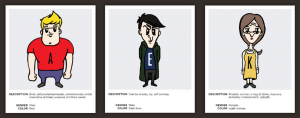
How about a short exercise of the personalities of Letters and Numbers?
Characteristics of Grapheme-Color Synesthesia
Grapheme Synesthesia belongs to the category, ideasthesia.
Ideasthesia means following: A concept (a letter) co-activates a sensory experience (colors). The colors associated with a letter or a number are consistent for the individual synesthete, but the colors differ among synesthetes.
So for me, letter “A” is blue, since I can remember it. For another person, it may be red. The colors hardly change over one’s lifespan. Though it requires attention to be aware of this synesthetic experience, the colors are perceived automatically and involuntary.
Take 10 minutes to explore your synesthetic perception of letters and numbers. It is for free.
Discover Grapheme Synesthesia
A Red Number “3” Is Ugly! – Synesthetic Stroop Effect
Synesthetes cannot agree on what the color of letter “A” is. It is different for everybody.
It is challenging and uncomfortable for a synesthete to imagine letter A in a “wrong” color. Imagining a letter in a wrong colors feels weird, and one can observe an enlargement of the pupils and a “flickering” of the eyes.
For me, a red “A” is ugly. And I did not like it at all when they imposed colored letters on me when I was still in school.
This uncomfortable feeling is also called a synesthetic Stroop effect. It is similar to reading the word “red” written with blue letters.

Synesthetic Color Trends for Letters and Numbers
Although the color experience is different for each person with synesthesia, there are certain trends. Letter A is most commonly red and the letter “O” as white. Some studies show that similar graphemes (such as A and 4) tend to have same colors.
More frequently used letters, such as “E” are more colorful compared to scarce one. Such as Letter “Q.”
One study shows that the higher a single digit number is, the darker it becomes. On average, number 2 is a brighter color than number 9.
Interestingly, people describe the number 0 and 1 often as black, white, transparent or bright and dark. How is it for you?
Researchers assumed that the colors of the letters and numbers do not derive from children’s textbook. Though a newer study showed that the magnetic toys that were popular in the 70s indeed could have influenced in forming letter color connections.
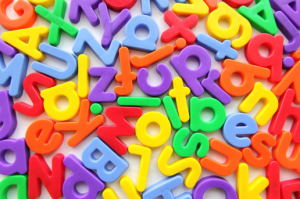
Neuronal Base of Grapheme-Color Synesthesia
For people with synesthesia, the brain’s grey matter is denser in specific areas. Furthermore, there is a higher density of connective tissue, or white matter, between different regions of the brain.
If a synesthete hears a letter or a number the areas of the brain associated with grapheme recognition is activated. Additionally, other regions are co-activated, such as the visual cortex that produces the color experience. This co-activation leads to the blending of the senses!
You can see here the EEG of a person with synesthesia (it’s my brain) and without. For more about Synesthesia on the brain, read our article here.
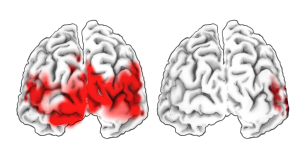
Diagnosing synesthesia is challenging, and your personal experience is much more important than the outcome of a such a “quiz,” so do not take the result too seriously.
Attention is required to perceive synesthesia
To perceive synesthetic experience attention is needed. Though the colors of the letters are automatic, if you do not focus on it, you will not recognize it.
You are aware of what you shift your attention to. For example, In the following picture, you see the numbers. Depending on what you focus, you see either the color of number 8, 2, or 3.
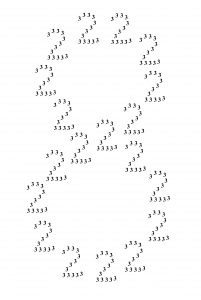
Many People Are Not Aware of Synesthesia
As mentioned attention and awareness of the senses is required to perceive synesthesia. Studies are showing that people that meditate regularly are more likely to have synesthetic perceptions.
One goal of Meditation is to shift attention to internal or external perceptions. Or the two synesthesia research pioneers Prof. Eagleman and Prof. Cytowic put it:
Learn to meditate if you hope to experience Synesthesia.
In the Sensorium, you find over 150 exercises that combine synesthetic explorations and traditional mindfulness. They may support you in your journey of becoming aware of Synesthesia.
Discover Synesthesia
Watch Our Video!
Synesthesia Meditation – synesthetic Mindfulness for sensory Awareness
Guided Synesthesia Meditation is a combination of mindfulness exercises and synesthetic explorations. Practice 10 minutes per day. Increase your synesthetic mindfulness* and sensory awareness. Find better sleep, increase feelings of calm, relaxation and balance, while decreasing stress, and gaining improved focus and life quality. Over 150 exercises are available on https://synesthesia.com.
What is it that evokes the color? The shape or the meaning?
Semantic meaning could be what triggers the color experience. For example in the picture below, you see that the symbol of 5 and S as the same shape. Depending on the context, people interpret it as letter S or as number 5. Letter S evokes another color than number “5”.
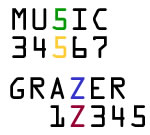
A study by Julia Simner with School children also confirms the importance of the meaning. For students that recently learned the alphabet, the synesthetic colors are not yet established and so are not consistent.
But after two years the color associations are more established and consistent. Probably the meaning of the letter is inherent then.
The conclusion is that probably the meaning of the letter is what creates the color experience, and not the shape. So Grapheme-Color Synesthesia needs some time until it establishes.
Benefits for learning tasks with colored letters and numbers?
Synesthesia provides the opportunity to involve different sensory modalities into learning processes. Some studies have found cognitive advantages, such as increased creativity or memory.
There are many people with synesthesia, and they come in all shapes and personalities. Having Grapheme-Color synesthesia does not automatically make somebody a math genius or language prodigy.
The numbers tell you stories while doing math
So for some people, the numbers are colorful personalities. When they do calculations, such as 3 x 4 = 12, they perceive a scenery and story. Such synesthetic perceptions may facilitate calculations in the head.
When learning languages, vocabulary is crucial. But as we know, it is also kind of boring and repetitive to learn. Here synesthesia can help. The words consist of colors evoked by the letters. It creates a kind of a color code. Being aware of the colors of a word in a foreign language can help to memorize and retrieve it. Sometimes I remember first the colors, then the word.
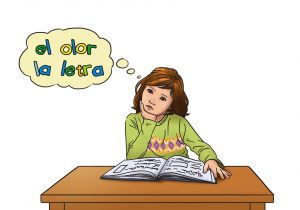
The colors of the Latin writing system transfer very easy and fast to another scripture.
This transfer of colors can happen within 10 minutes. Danko Nikolic calls this cross-linguistic transfer. When I was learning Hebrew, in the beginning, all those letters were just black. Very soon, while learning the meaning of the Hebrew letters, they got the colors of the Latin system.
Of course, it did not work one by one because of specific particularities of the Hebrew system, but it helped.
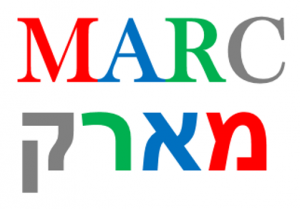
I need to mention that the research of synesthesia and memory is still in its “infancy.” We need more studies to understand synesthesia as an advantage in learning processes.
Not All Synesthetes Are the Same – Projectors and Associators.
Synesthetes can be differentiated. People with synesthesia report, that reading or thinking about a letter, evokes the perception of the colors in space. They are called “Associators” because they see the colors with their mind’s eye.
Though, some report that they see the colors directly on the page of a book. These colors compete with the printed color on the sheet.They are called projectors. There are fewer projectors than associators. It seems that they have even a stronger neuronal connection between the different areas of the brain.
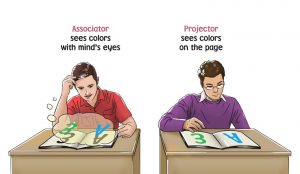
Can Synesthesia be learned?
It was assumed that synesthesia could not be learned. There is a newer study claiming that one could train synesthesia, at least partially. People without synesthesia went through a synesthesia training over an over the course of weeks.
After a “letter-color” training the participants reported synesthesia-like experiences.
They learned Grapheme-Color associations. After a while, they started to report synesthesia typical experiences. They passed synesthesia tests like synesthetes and showed a general enhancement of cognitive abilities. Even a rise in IQ was measured.
Those effects were only temporary. Once they stopped with the training, it disappeared. However, this opened up the question, how can we all benefit from synesthesia.
Furthermore, there has been evidence, that non-synesthetic relatives of synesthetes can “achieve synesthetic experiences” and an alteration of the brain, by synesthesia training.
If you can cause synesthesia with training or meditation is unclear at this point. It may be more likely that those tools help to unfold existing synesthetic abilities.
If you want to give it a go, try our Synesthesia-Training in form of sensory mindfulness exercises.
Ask Your Friends And Family for Colored Letters And Numbers!
In the past, we thought of synesthesia as a rare phenomenon that only a few people have and enjoy. As a consequence, many synesthetes felt alone with their synesthetic abilities. Often they did not dare to talk about it.
But luckily nowadays, we understand synesthesia much better and more information is available. There are many more synesthetes around you than you may think.
There is a high chance that you can locate others with synesthesia in your circle of friends and your family. Let them close their eyes and ask them for the colors of a few letters. You will be surprised.
And in case you do not dare to do that, well, then send them this link. However, try it your yourself, too!
How to approach Friends that may be synesthetes?
Read our article about synesthesia awareness. You will find some insights about how to talk to your friends and family about synesthesia. And why they may be unaware synesthetes.
What to do next?
In the Sensorium, you can find over 150 synesthetic mindful exercises to discover your synesthetic perception.
Over 3 hours of free Synesthesia Meditation
You can start your mindful synesthetic journey in the Gateway. For free! No registration needed!
Or maybe you motivated to do a test? Check out our Test series in the Gateway:
Tests in the Gateway
Artwork by Fitri
